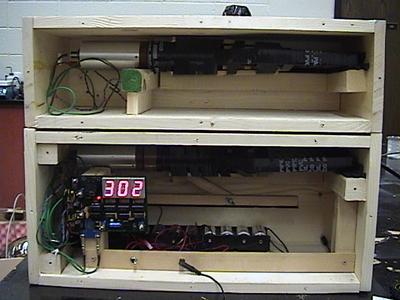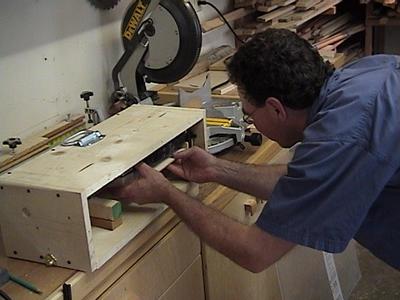19 July, 2002
I brought a portable cosmic ray detector to River Falls ! And we (maybe)
broke it - while making it better ! Has that ever happened to you ?
The detector is a simple "lightweight" design by Howard Matis of
Lawrence Berkeley Labs. To register a count, it relies on coincidence : a
simultaneous "hit" in each of 2 individual detectors. Since this type of
detector is noisy, firing occasionally by itself, 2 detectors are used in
coincidence to help eliminate random noise.
The detector uses a piece of plastic doped with a fluorescent molecule.
High energy parcticles stream though the plastic at about 10 Hz. These are
usually muons, a kind of high-energy electron created in the Earth's
atmosphere by protons from the Sun. As the muons pass through the plastic,
they disturb the fluorescent molecules and cause them to radiate a faint
violet-blue light. A PMT (photomultiplier tube) senses the light and
converts it to an electronic signal.
This system has been used for years in both astrophysics and parcticle
accelerators like the ones at FermiLab and SLAC (the Stanford Linear
Accelerator). It's very similar to the detection system we'll use in our
WALTA (Washington Area Large-scale Time-coincidence Array), where we're
planning to install detectors at schools throughout the greater Seattle
region, to detect the large footprints of ultra-high energy parcticles.
Jim Madsen of the University of Wisconsin at River Falls suggested I
take it to the South Pole ! So I brought it along to Wisconsin when I
attended the Astronomy in the Ice course, and we worked on making a robust
shipping crate and reinforcing the PMT-scintillator junction, which, even
though held together with epoxy, has proven very vulnerable to breakage.
Other plans for the detector include : a) a hot-air balloon flight to
reproduce the data that led to the discovery of cosmic rays by Victor Hess.
b) piggybacking on a NASA high altitude balloon experiment, to collect data
from above most of the atmosphere. c) sending the detector to Sweden with
TEAs Jason Petula and Mats Petterson. d) sharing the detector among local
WALTA teachers.
Lots of sources contributed to the construction of the detector.
QuarkNet & FermiLab donated the PMTs, the most expensive part. Howard Matis
donated the circuit board and the analog IC chips. A NASA mini-grant
provided $ 400 toward construction. I paid for the rest ! Students did
almost all the original soldering and housing construction. Hans-Gerd Berns
of the University of Washington did the troubleshooting...
Howard Matis' website
http://www.lbl.gov/abc/cosmic/
My web page on the detector :
http://216.254.11.98/site_material/Matis_detector/MatisMuhs.html
Current Status : something went wrong with the board while Jim & I were
working with the shipping box & PMT splints. It's coming back to me, and
I'll be a) fixing it, b) taking it to Vernier software in Portland to get
help on data collection, c) demonstrating it in our next WALTA workshop for
teachers in early August, d) shipping it to Jason to ake on his trip to
Sweden.
Wow !

The detector as it arrived at River Falls. Jim Madsen & I went to a lot of trouble to make it stronger, so it might have a chance of arriving at the South Pole ready to collect data.

Jim Madsen fits the highly reinforced scintillator/PMT inside the top box of the detector.
Contact the TEA in the field at
.
If you cannot connect through your browser, copy the
TEA's e-mail address in the "To:" line of
your favorite e-mail package.
|
